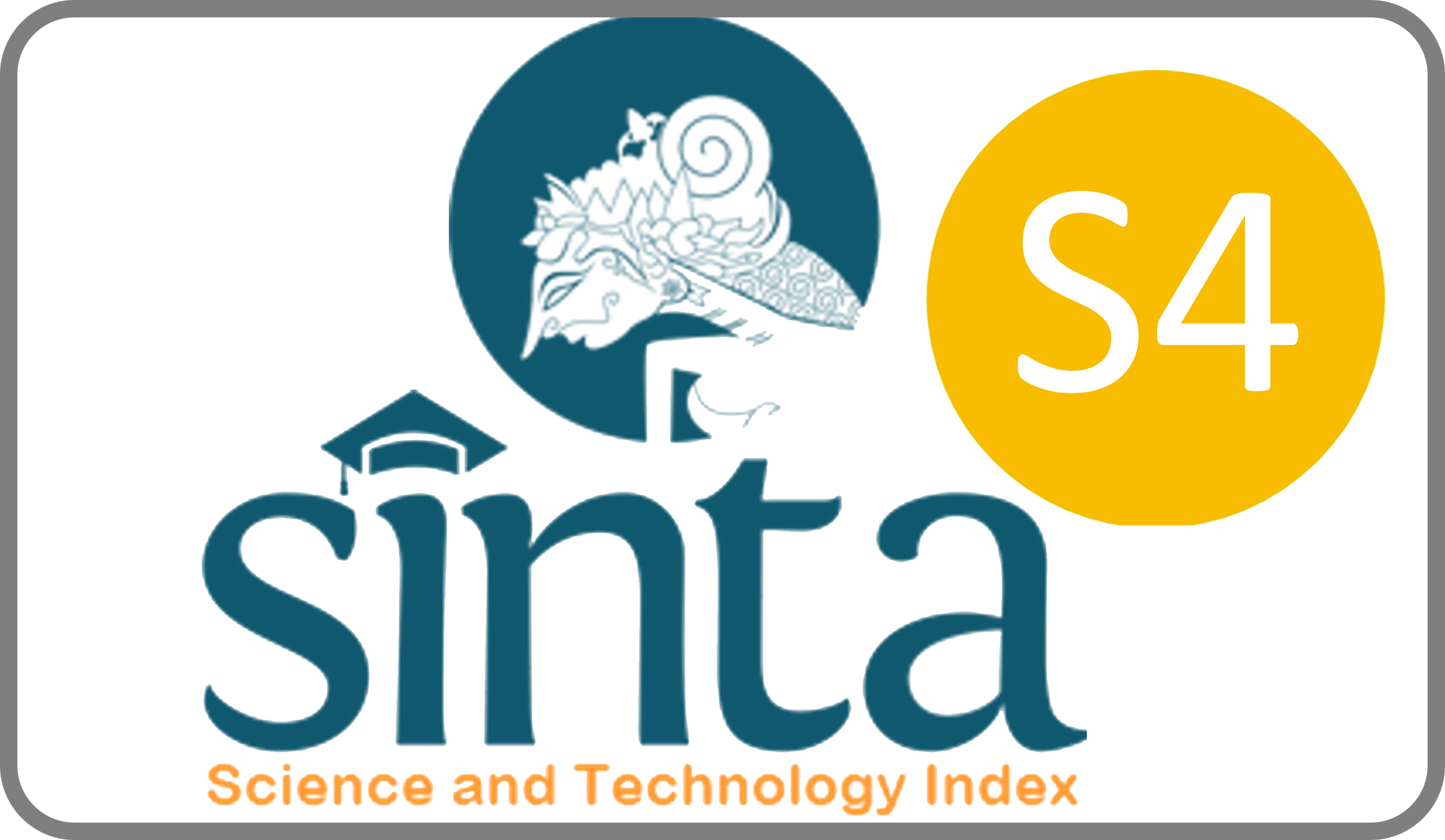PENGEMBANGAN MANAJEMEN PELATIHAN SUMBER DAYA MANUSIA BERDASAR SISTEM ADDIE PADA APARATUR DI BADAN PENGEMBANGAN SDM PROVINSI JAWA TIMUR: DIGITALISASI TRAINING NEEDS
Downloads
Program Pengembangan Sumber Daya Manusia (SDM) sangat penting dalam meningkatkan kinerja aparatur dan mendukung organisasi mencapai tujuannya. Pengembangan SDM dilakukan dalam bentuk kegiatan pelatihan (training). Secara konseptual, training dilakukan berdasarkan model atau sistem ADDIE yaitu tahap-tahap Training Needs Analysis, Training Design, Training Program Development, Training Implementation, dan Training Evaluation. Pelaksanaan semua tahap pelatihan tersebut tidak lepas dari teknologi digital. Tujuan pengabdian kepada masyarakat ini adalah untuk mengembangkan aplikasi sebagai bagian dari teknologi digital untuk digunakan dalam penyusunan analisis kebutuhan pelatihan. Lokasi kegiatan adalah Badan Pengembangan Sumber Daya Manusia (BPSDM) Pemerintah Provinsi Jawa Timur yang selama ini belum sepenuhnya menggunakan teknologi digital termasuk dalam menganalisis kebutuhan pelatihan. Metode yang digunakan adalah ceramah tatap muka dan diskusi serta Focus Group Discussion (FGD) untuk menyepakati fitur-fitur (features) yang harus diakomodasi dalam aplikasi. Hasil pengabdian kepada masyarakat menunjukkan manfaat bagi BPSDM Jawa Timur dalam menyusun dan mengembangkan analisis kebutuhan pelatihan secara digital dan diperlukan kerja sama secara berkelanjutan untuk mendukung digitalisasi program pengembangan SDM aparatur.
Bjerke-Busch, L.S. & Aspelund, A. (2021). "Identifying Barriers for Digital Transformation in the Public Sector: Management for Professionals.” in: Daniel R.A. Schallmo & Joseph Tidd (ed.). Digitalization. pp 277-290, Springer. https://doi.org/10.1007/978-3-030-69380-0_15
Chytiri, A.P. (2019). Human Resource Managers' Role in the Digital. Era Journal of Economics and Business. 69(1-2): pp. 62-72.
Fulmer, IS & Ployhart, R.E. (2014). Our Most Important Asset: a Multidisciplinary/Multilevel Review of Human Capital Valuation for Research and Practice. Journal of Management. 40(1): pp. 161–192. https://doi.org/10.1177/0149206313511271
Hendriarto, P. (2021). Understanding of the Role of Digitalization to Business Model and Innovation: Economics and Business Review Studies. Linguistics and Culture Review. 5(S1): pp. 160-173. https://doi.org/10.37028/lingcure.v5nS1.1347
Hoffmann, T. (1999). The Meanings of Competency. Journal of European Industrial Training. 23(6): pp. 275-286. https://doi.org/10.1108/03090599910284650
Isabel, M., Aragón, B., Jiménez, D.J., Valle, R.S. (2014). Training and Performance: The Mediating Role of Organizational Learning. Business Research Quarterly. 17(3): pp. 161-173. https://doi.org/10.1016/j.cede.2013.05.003
Kozlowski, S.W.J., Gully, S.M., Brown, K.G., Salas, E., Smith, E.M., Nason, E.R. (2001). Effects of Training Goals and Goal Orientation Traits on Multidimensional Training Outcomes and Performance Adaptability. Organizational Behavior and Human Decision Processes. 85(1): pp 1-31. https://doi.org/10.1006/obhd.2000.2930
Mahmud, K.T., Wahid, I.S., & Arif, I. (2019). Impact of Training Needs Assessment on the Performance of Employees: Evidence from Bangladesh. Cogent Social Sciences. 5(1): 1705627. https://doi.org/10.1080/23311886.2019.1705627
Markaki, A., Malhotra, S., Billings, R., & Theus, L. (2021). Training Needs Assessment: Tool Utilization and Global Impact. BMC Medical Education. 21: 310. https://doi.org/10.1186/s12909-021-02748-y
Mayfield, M. (2011). Creating Training and Development Programs: Using the ADDIE Method. Development and Learning in Organizations. 25(3): pp.19-2. https://doi.org/10.1108/14777281111125363
Reed, J. & Vakola, M. (2006). What Role Can a Training Needs Analysis Play in Organisational Change? Journal of Organizational Change Management. 19(3): pp. 393-407. https://doi.org/10.1108/09534810610668382Kdkkd
Smart, D.L., & Wolfe, R.A. (2007). The contribution of leadership and human resources to organizational success: An empirical assessment of performance in major league baseball. European Sport Management Quarterly. pp.165-188. https://doi.org/10.1080/16184740308721949
Swanson, R.A., (2001). Human Resource Development and its Underlying Theory. Human Resource Development International. 4(3): pp. 299-312.
Trihapsari, C., Mujahidah, F., & Humairoh, N. (2021). Enhancement of the Quality of Human Resources through Training and Development Programs in Schools Al-Tanzim: Jurnal Manajemen Pendidikan Islam. 5(2): pp. 145-153 Available online at https://ejournal.unuja.ac.id/index.php/al-tanzim/index
Velada, R., Caetano, A., Michel, J.W., Lyons, B.D., & Kavanagh, M.J. (2007). The Effects of Training Design, Individual Characteristics and Work Environment on Transfer of Training. International Journal of Training and Development. 11(4): pp. 282-294
Vey, K., Fandel-Meyer, T., Zipp, J.S., & Schneider, C. (2017). Learning & Development in Times of Digital Transformation: Facilitating a Culture of Change and Innovation. International Journal of Advanced Corporate Learning. 10(1): pp. 22. https://doi.org/10.3991/ijac.v10i1.6334
Vukovic, G., Zavrsnik, B., Rodic, B., & Miglic, G. (2008). The Training of Civil Servants in the Slovene State Administration: Issues in Introducing Training Evaluation. International Review of Administrative Sciences. 74(4): pp. 653–676. https://doi.org/10.1177/0020852308098473
Wang, J., Hutchins, H,M., & Garavan, T.N. (2009). Exploring the Strategic Role of Human Resource Development in Organizational Crisis. Management Human Resource Development Review. 8(1): pp.22-53 https://doi.org/10.1177/1534484308330018

This work is licensed under a Creative Commons Attribution-ShareAlike 4.0 International License.
JLM by Unair is licensed under a Creative Commons Attribution-ShareAlike 4.0 International License.
1. The journal allows the author to hold the copyright of the article without restrictions.
2. The journal allows the author(s) to retain publishing rights without restrictions
3. The legal formal aspect of journal publication accessibility refers to Creative Commons Attribution Share-Alike (CC BY-SA).
4. The Creative Commons Attribution Share-Alike (CC BY-SA) license allows re-distribution and re-use of a licensed work on the conditions that the creator is appropriately credited and that any derivative work is made available under "the same, similar or a compatible license”. Other than the conditions mentioned above, the editorial board is not responsible for copyright violation.


















